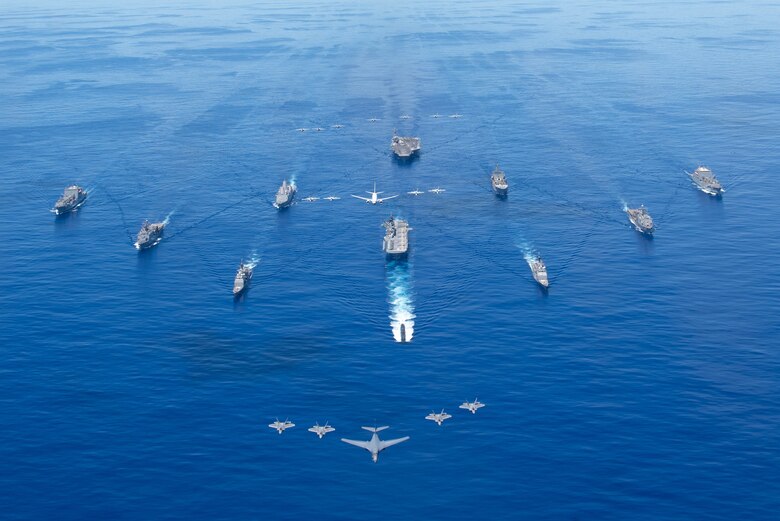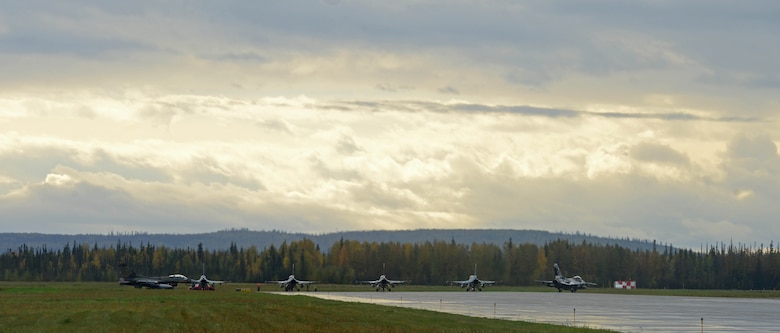The eighth iteration of exercise Valiant Shield concluded Sept. 25 following 12 days of joint operations at sea, in the air, on land, and in cyberspace.
During the exercise, more than 11,000 Soldiers, Marines, Sailors and Airmen synchronized to train in a real-world environment to demonstrate their readiness to respond to any contingency at a moment's notice.
"Valiant Shield is the perfect opportunity for the U.S. military to come together in a high-end training, joint environment to ensure the United States military maintains our competitive advantage," said U.S. Navy Rear Adm. James Aiken, Valiant Shield 20 director. "More importantly, this exercise assures our allies and partners that we take securing peace and stability in the Indo-Pacific region seriously."
Sinking success
The pinnacle event was the exercise to sink the decommissioned frigate USS Curts (FFG 38), otherwise known as a SINKEX, Sept. 19. The SINKEX included air-launching ordnance from fixed and rotary wing squadrons of Carrier Air Wing (CVW) 5, embarked aboard USS Ronald Reagan (CVN 76), surface launched missiles from cruisers USS Antietam (CG 54) and Shiloh (CG 67), as well as various supporting Navy and U.S. Air Force aircraft.
Air Force assets included the C-130J Super Hercules, EC-130, E-3 Sentry, F-16 Fighting Falcon, F-22 Raptor, KC-10 Extender, and the KC-135 Stratotanker.
"The SINKEX provided unique, high-end, tactical training for our air wing aviators," said U.S. Navy Capt. Michael Rovenolt, Carrier Air Wing 5 commander. "The experience gained by our crews can only be achieved with live fire events like this one and cannot be replicated through simulated engagements."
For the SINKEX to be a complete success, following environmental and animal protection measures is a must.
Prior to the exercise, a survey verified there were no humans or marine mammals in the area.
The crew thoroughly cleaned the vessel of polychlorinated biphenyls, transformers, and large capacitors; all small capacitors to the greatest extent practical; trash; floatable materials; mercury or fluorocarbon-containing materials and readily detachable solid PCB items. They also cleaned petroleum from tanks, piping and reservoirs.
The work was then inspected and certified in accordance with Environmental Protection Agency requirements. The SINKEX occurred at least 50 nautical miles from land and sank at least 6,000 feet deep in compliance with regulations.
The Navy routinely conducts SINKEX events to increase readiness by allowing forces to plan and execute tactics and test weapon effectiveness.
All together now
A U.S.-only exercise enhances military training with a high-end Joint All-Domain training environment using Live-Virtual-Constructive training enablers to simulate the live tactical forces with constructive, synthetic opposing forces.
"This was our opportunity to highlight to our allies and partners that we are dedicated to a free and open Indo-Pacific, while also showcasing our warfighting potential to our near-peer adversaries," said U.S. Air Force Col. Brian Baldwin, 36th Air Expeditionary Wing commander and Valiant Shield Air Component director.
In addition to the SINKEX, the exercise tested operating in different domains. For the first time ever, the Army validated the Multi Domain Task Force during this exercise.
"The ability to rapidly surge combat-ready forces using Army watercraft across the theater is critical to projecting forces at a moment's notice to support regional alliances and reinforce the existing security architecture," said U.S. Army Col. Theodore White, 8th Theater Sustainment Command deputy commanding officer. "Participating in joint exercises like Valiant Shield allow Army watercraft to integrate with the joint force to meet the Theater Joint Force Land Component Commander's intent."
The Air Force incorporated the Advanced Battle Management System, which integrated existing and future sensors, weapons, and battle management command and control systems. Additionally, the Air Force tested Agile Combat Employment to validate new ways to move assets, during a crisis or conflict.
The Marine 5th Air Naval Gunfire Liaison Company provided real-time guidance support for a live-fire sea-based TLAM strike on a ground target. Moreover, the America Amphibious Ready Group-31st Marine Expeditionary Unit is the Marine Corps' only continuously forward-deployed MEU, operating aboard ships of the America Expeditionary Strike Group in the Indo-Pacific region, providing a flexible and lethal crisis response force.
Real-world training during COVID-19
While Valiant Shield is a training exercise held biennially in a real-world environment, the 2020 exercise was scaled down from previous years due to the global COVD-19 pandemic.
"We are determined to uphold our commitments to our allies and partners in order to preserve the security of our nation and the peace and stability of the Indo-Pacific. We cannot do that if we don't train," said U.S. Air Force Brig. Gen. Jeremy Sloane, 36th Wing commander. "We synchronized our medical and public health professionals within the exercise planning to ensure we kept military members, families, and the local communities safe, while still accomplishing those joint training objectives."
While the exercise is typically held in Guam, this year, a contingent of servicemembers operated from Joint Base Pearl Harbor-Hickam to minimize the footprint. Servicemembers were either required to quarantine for 14 days and arrive via military air or arrive via commercial air and quarantine for 14 days. Prior to participating in the exercise, all service members were required to test negative for COVID-19.
All participants were only authorized to travel to work and their hotels to further mitigate the spread of the virus. Furthermore, all participants followed Centers for Disease Control guidance such as wearing face masks, social distancing, frequent hand washing, daily temperature checks and single points of entry, identifying all close contacts, and sanitizing workspaces.
As Valiant Shield 2020 comes to an end, the planning for Valiant Shield 2022 begins with the incorporation of lessons learned from the past two weeks, so the military remains ready to defend the nation.

Ships participating in exercise Valiant Shield 2020 steam in formation while E/A-18G Growlers and FA-18E Super Hornets from Carrier Air Wing (CVW) 5, a P-8 Poseidon assigned to Commander Task Force 72, and U.S. Air Force F-22 Raptors and a B-1B Bomber fly over the formation. Valiant Shield is a U.S. only, biennial field training exercise with a focus on integration of joint training in a blue-water environment among U.S. forces. This training enables real-world proficiency in sustaining joint forces through detecting, locating, tracking and engaging units at sea, in the air, on land and in cyberspace in response to a range of mission areas. (U.S. Navy photo by Mass Communication Specialist 3rd Class Jason Tarleton)

F-16 Fighting Falcons assigned to the 18th Aggressor Squadron prepare to take off in support of exercise Valiant Shield at Eielson Air Force Base, Alaska, Sept. 8, 2020. As experts in enemy tactics, techniques and procedures, the Aggressors' role is to replicate the enemy in the air to provide a realistic training environment. Valiant Shield 20 provides a unique opportunity for Pacific Air Force to train with other services, increasing their ability to work collaboratively should the need arise. (U.S. Air Force photo by Staff Sgt. Sean Martin)






